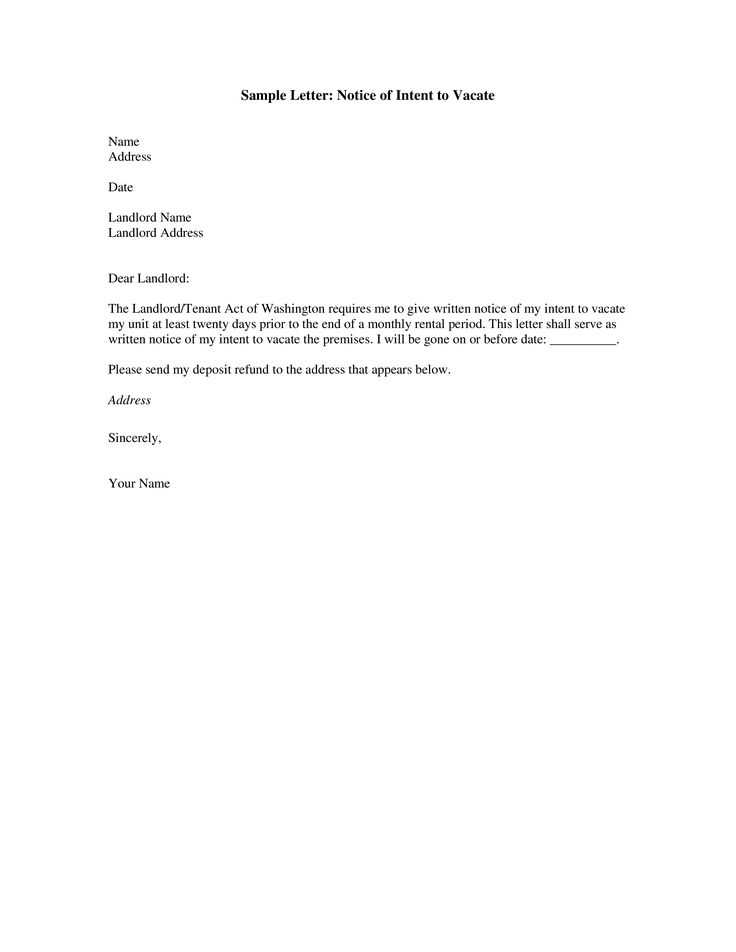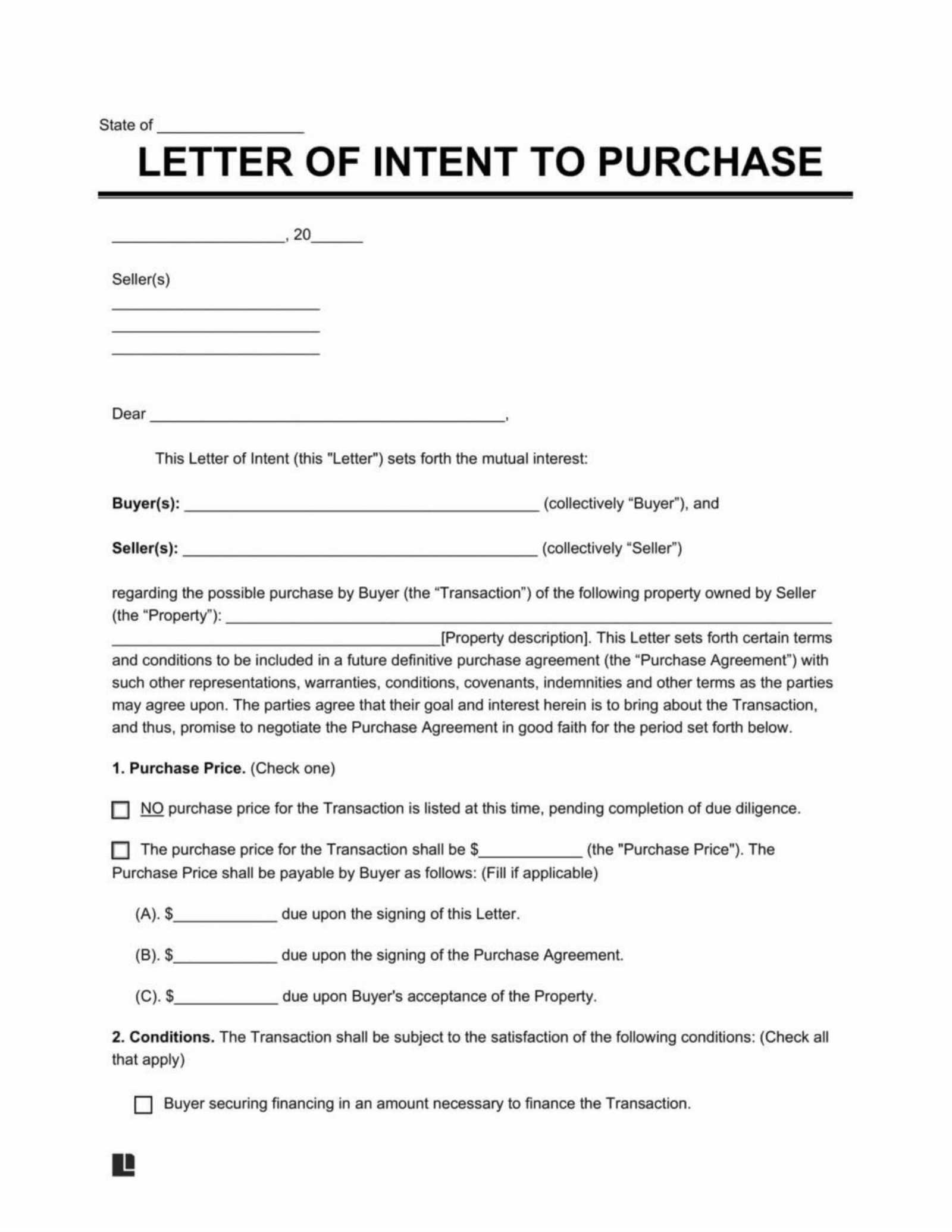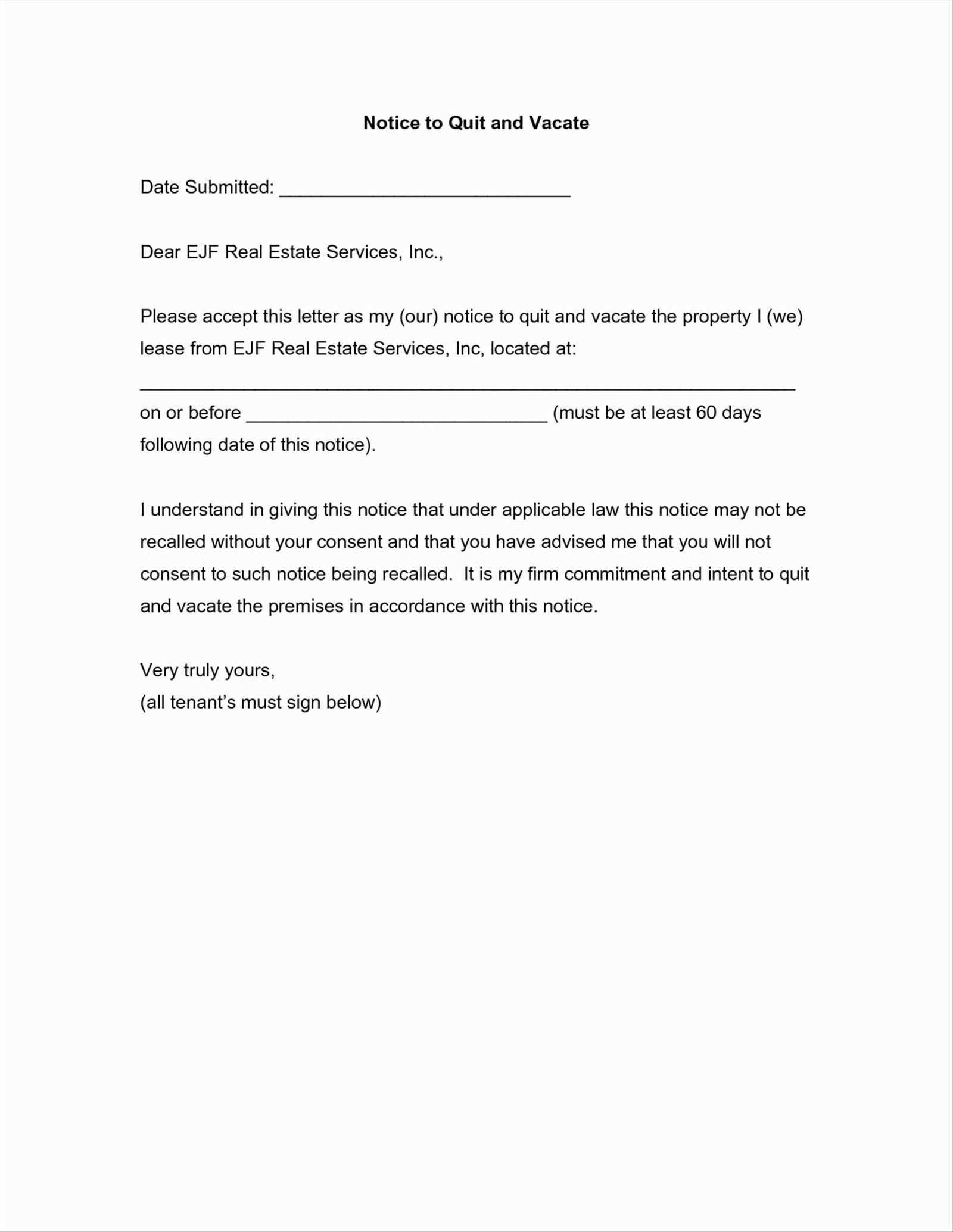Notice of intent to vacate letter template

If you’re preparing to vacate your rental property, submitting a formal notice of intent to vacate is a necessary step to ensure a smooth transition. A well-crafted letter can prevent confusion and demonstrate professionalism. This letter serves as a formal declaration of your intention to move out, specifying your planned departure date and providing landlords with the necessary time to prepare for the next tenant.
To write an effective notice, include essential details such as your name, address, and the exact date you plan to vacate. Clearly state that this letter is your formal notice of intent and provide any additional context if needed, such as a reason for moving out (though this is not mandatory). A polite tone goes a long way, even if you’re not entirely satisfied with your living situation. Use this as an opportunity to leave on good terms, ensuring a positive reference for future rentals.
Below, you’ll find a template that covers all the necessary elements. Customize it to fit your specific circumstances, and remember to send it in a timely manner to give your landlord proper notice as required by your lease agreement. Whether you’re moving across town or across the country, this simple document ensures both parties are aligned on your move-out details.
Here’s the revised version where repeated words have been replaced:
When you draft your Notice of Intent to Vacate letter, clarity and precision are key. Avoid redundancy to make the communication more professional. Replace repeated words with synonyms or restructure sentences to maintain flow.
Remove Redundant Phrases
For example, instead of writing “I intend to vacate the property by the date of February 15,” use “I plan to vacate by February 15.” This eliminates unnecessary repetition of “vacate” and keeps your statement concise.
Rephrase for Clarity
Ensure your notice includes key details like the date of move-out, the address, and any specific instructions about the condition of the property. A well-organized letter shows respect for both parties and helps avoid confusion later.
- Notice of Intent to Vacate Template
Use the following template for a clear and professional notice of intent to vacate. Adjust the details to fit your situation.
Tenant’s Name: [Your Full Name]
Address: [Your Current Address]
Date: [Date of Notice]
Recipient’s Name: [Landlord’s Full Name or Property Management]
Address: [Landlord’s Address]
Dear [Landlord’s Name],
I am writing to inform you of my intent to vacate the premises located at [Rental Address]. According to the terms of the lease agreement, I will vacate on or before [Date of Move-out]. I understand that this notice complies with the notice period required by our lease agreement.
Please let me know the next steps for returning the keys and scheduling a move-out inspection. I would also appreciate it if you could confirm any final procedures regarding the security deposit and any outstanding payments.
Thank you for your cooperation. Please feel free to reach out if you need further information.
Sincerely,
[Your Full Name]
| Details | Information |
|---|---|
| Tenant Name | [Your Full Name] |
| Rental Address | [Your Rental Address] |
| Notice Date | [Date of Notice] |
| Move-out Date | [Date of Move-out] |
A clear and concise structure is key when writing a vacate intent letter. Focus on providing all necessary details in an organized way to avoid confusion. Start with a straightforward introduction stating your intention to vacate the property. Include the specific date you plan to leave and ensure it aligns with the terms of your lease agreement.
Opening Statement
Begin with a brief sentence confirming your intent to vacate. For example: “I am writing to inform you of my intention to vacate the property at [address] on [date].” This makes it immediately clear to the landlord what the purpose of the letter is.
Details of the Lease Agreement

Next, mention your lease agreement details, such as the start and end dates. Reference the lease term, which helps provide context for your notice. For instance, “As per the terms of my lease agreement, I am required to provide [notice period] notice, which I am fulfilling by submitting this letter.” This ensures both parties understand the timeline and obligations involved.
Close with a polite statement offering to assist with the move-out process or schedule a property inspection. Conclude with your contact information for follow-up. A simple closing, like “Please let me know if you need further information or if there are any additional steps I should take before vacating,” will leave the door open for communication.
Be clear about your intention to vacate and the date you plan to move out. Specify your lease term’s end date or the notice period required. The more precise you are, the easier it will be for both parties to plan accordingly.
Include your full name, address, and the rental property’s details. This ensures that the letter is linked to the correct agreement, helping avoid any confusion.
If applicable, mention your forwarding address for the return of your security deposit or future correspondence. It’s helpful to add any specific instructions related to the move-out inspection or key return, ensuring a smooth handover.
If you’re terminating the lease early, reference the lease clause that permits this action. If you have any questions or require clarification, express your willingness to discuss it further.
| Detail | Description |
|---|---|
| Full Name & Address | Ensure your details are clear, so the landlord can easily identify you. |
| Move-Out Date | Specify the exact date you plan to leave, complying with the notice period. |
| Forwarding Address | Include this for the return of your security deposit and any further communication. |
| Lease Terms | Refer to relevant clauses if ending the lease early, especially if required. |
By including these key details, you ensure clarity and reduce the chances of any misunderstanding during the move-out process.
Avoid vague or unclear language in your notice. Specify the exact date you plan to vacate the property and ensure the time frame aligns with the terms in your rental agreement. Without clarity, the landlord may misunderstand your intent and create unnecessary delays.
Incorrect Addressing
Do not forget to address the letter correctly. It should be directed to your landlord or property manager, and if there is a particular department handling such requests, mention that specifically. Failure to address it properly can lead to confusion or it being overlooked.
Omitting Required Details
Include all the necessary information like your full name, address, and rental unit details. Missing any of these could cause delays or lead to issues with your security deposit or final inspection. Review your contract to confirm what details are needed for clarity.
When submitting a notice of intent to vacate, tenants must adhere to specific legal responsibilities. These obligations ensure the process is smooth and that both parties meet their contractual requirements. It’s vital to follow the correct procedure to avoid legal issues or penalties.
Understanding the Lease Agreement
Start by reviewing the lease agreement thoroughly. Many leases include a specific notice period that must be provided before vacating the premises. Typically, the standard notice period ranges from 30 to 60 days, but this can vary. Make sure to comply with the stipulated timeframe to avoid breaking the lease terms.
Written Notice Requirement
Most jurisdictions require that the notice of intent to vacate be submitted in writing. This document should clearly state the tenant’s intention to move out, along with the exact date of departure. Verbal notices are not usually legally binding.
- Include your name, address, and rental unit details.
- State the exact move-out date, ensuring it aligns with the notice period required by the lease.
- Consider using certified mail or another trackable method to send the notice, ensuring delivery confirmation.
Property Condition and Security Deposit
Before vacating, tenants should leave the rental unit in good condition. Many leases specify that tenants must return the property in the same state as it was upon move-in, minus reasonable wear and tear. Landlords are entitled to keep part or all of the security deposit if there are damages beyond normal use.
- Clean the unit thoroughly, including carpets, appliances, and windows.
- Repair any damage, such as holes in the walls or broken fixtures.
Returning Keys and Access Devices

Another obligation tenants must fulfill is the return of all keys, garage openers, and any other access devices issued at the beginning of the lease. Failure to return these items can result in charges for replacement or rekeying costs.
Final Utility Payments
Ensure all utility bills are settled before vacating. Landlords typically expect tenants to pay for services like electricity, water, and gas until the end of the lease term. Unpaid bills can affect the tenant’s credit or result in additional charges.
- Contact utility companies to close accounts and avoid overcharges.
- Provide forwarding information for any final billing or correspondence.
Send the notice in writing to ensure there is a record of your intent. You can do this via email, mail, or hand delivery. Each method has its advantages and potential risks, so choose the one that works best for your situation.
By Mail
If you send the notice by mail, use certified mail with a return receipt requested. This will provide proof that the landlord received the letter. Make sure to keep a copy of the receipt and the notice for your own records.
By Email
Sending the notice via email is quick and convenient. However, ensure you have a read receipt or confirmation from the landlord acknowledging receipt of the email. It’s wise to follow up if you don’t hear back within a reasonable time frame.
- Ensure the email contains the correct subject line and details of your move-out date.
- Attach the signed notice as a PDF for clarity.
In Person
If you prefer hand delivery, deliver the notice in person and ask for a signed acknowledgment from the landlord. This can help avoid misunderstandings, as both parties will have a record of the transaction.
Always double-check the lease agreement for any specific requirements on how the notice should be submitted. Some landlords may request that notices be submitted via a particular method or within a certain time frame. Sticking to the outlined requirements ensures that you comply with the contract and avoid potential disputes.
Actions to Take if the Landlord Refuses to Acknowledge the Notice
If your landlord ignores your notice to vacate, it’s important to take action to protect your rights. Follow these steps:
- Review Your Lease Agreement: Ensure the notice complies with the terms specified in your lease. Check for any clauses that may affect the timing and delivery method of the notice.
- Document Everything: Keep records of all communications with your landlord, including emails, letters, and phone calls. Take note of any attempts to deliver the notice and any responses or lack thereof.
- Send a Follow-Up Notice: If your initial notice went unacknowledged, send another notice. Use certified mail or another traceable method to confirm receipt.
- Consult Local Tenant Laws: Review local laws to ensure you’re following the correct procedures. Some jurisdictions may require a specific waiting period before you can take further action.
- Contact a Lawyer: If the landlord continues to ignore your notice, it may be time to seek legal advice. A lawyer can help you understand your rights and advise on the next steps, which may include court action.
- Consider Mediation: In some cases, mediation can help resolve conflicts without going to court. This can be a faster and less expensive option.
- File a Complaint: If your landlord’s refusal to acknowledge your notice violates local laws, file a formal complaint with your local housing authority or tenant’s rights organization.
Taking these actions ensures you protect your rights and move forward with your plans if your landlord is unresponsive.
Important Steps for Writing a Notice of Intent to Vacate
Make sure to include the exact date you plan to vacate the property. This helps avoid confusion and gives the landlord enough time to make arrangements. Specify the day when you will move out and when the keys will be returned.
Clear Communication
Clearly state your intention to leave the rental property. Avoid vague language and provide enough detail to ensure your landlord understands your plan. Mention the address of the property and your full name for identification.
Follow Lease Agreement Guidelines
Refer to your lease for the required notice period. If your contract demands 30 days’ notice, make sure you meet that timeframe. Failing to do so might result in penalties or complications when moving out.
If there are any security deposits, note the expectation of return, if applicable. It’s always good practice to provide a forwarding address for any future communications or refund checks.